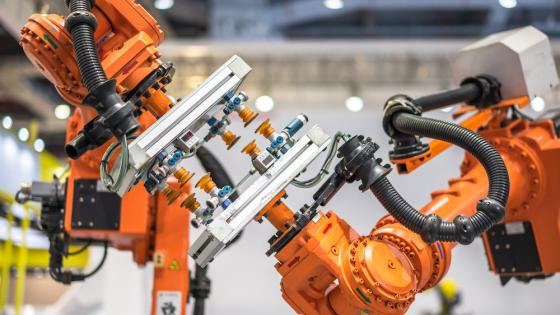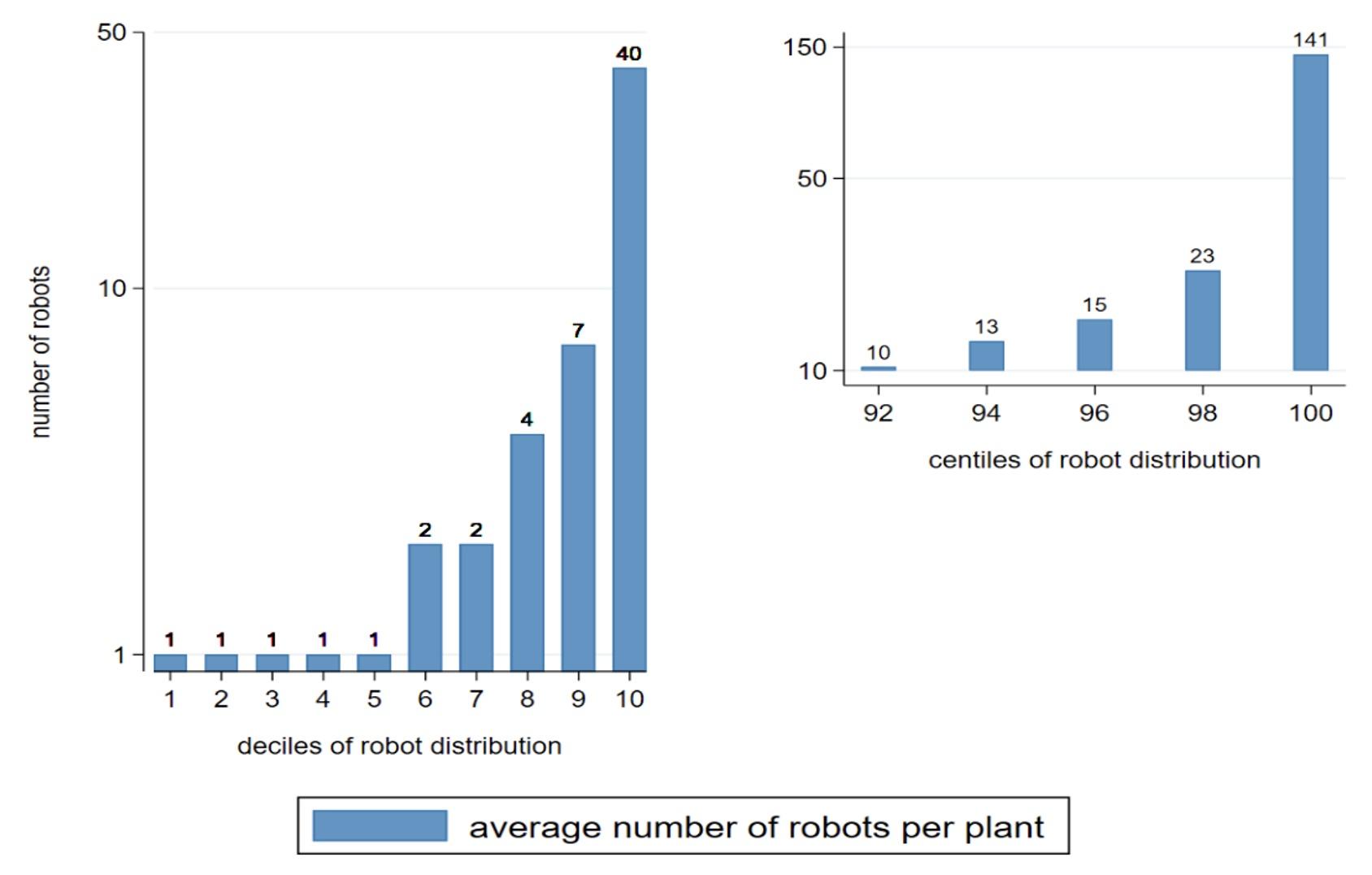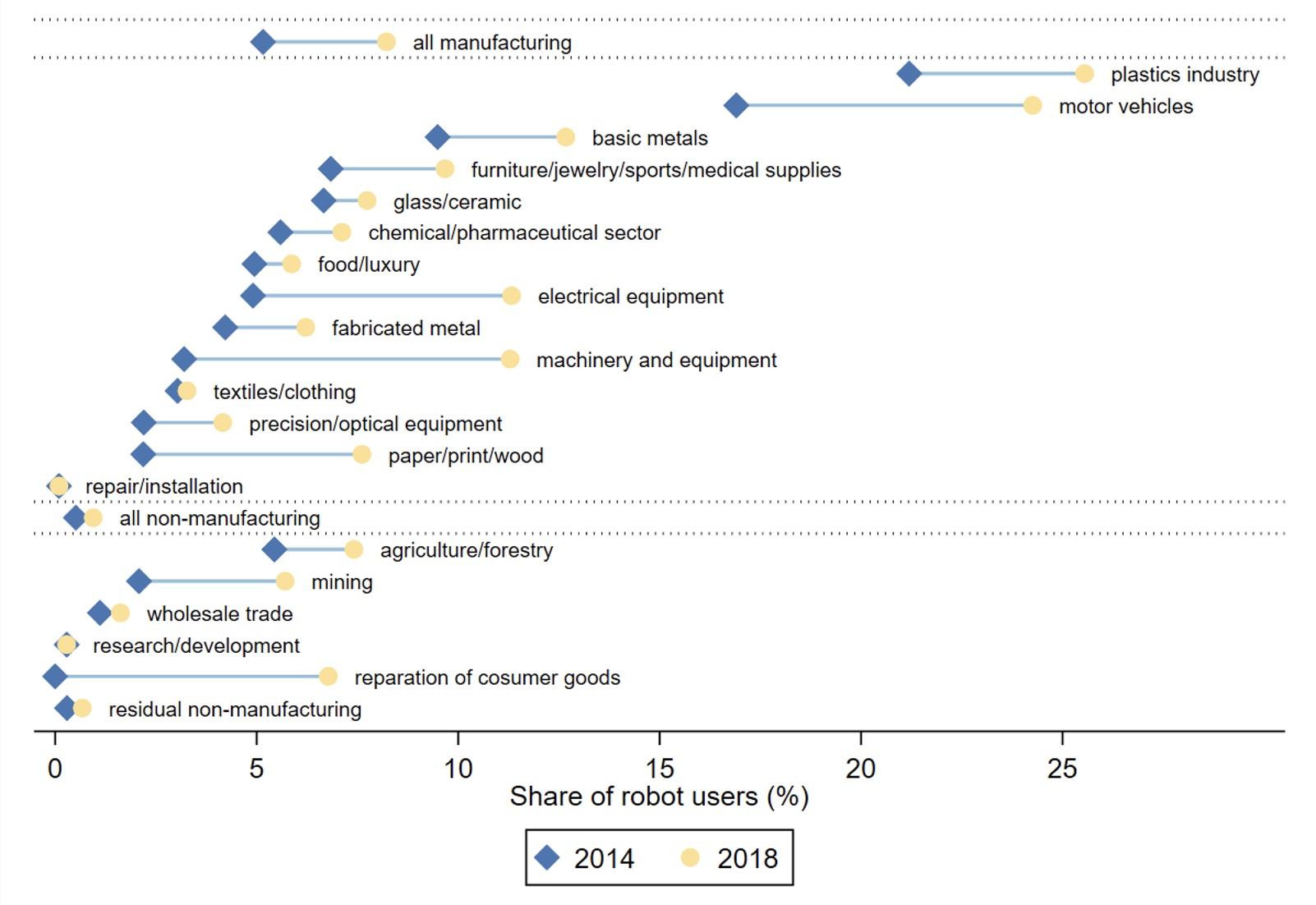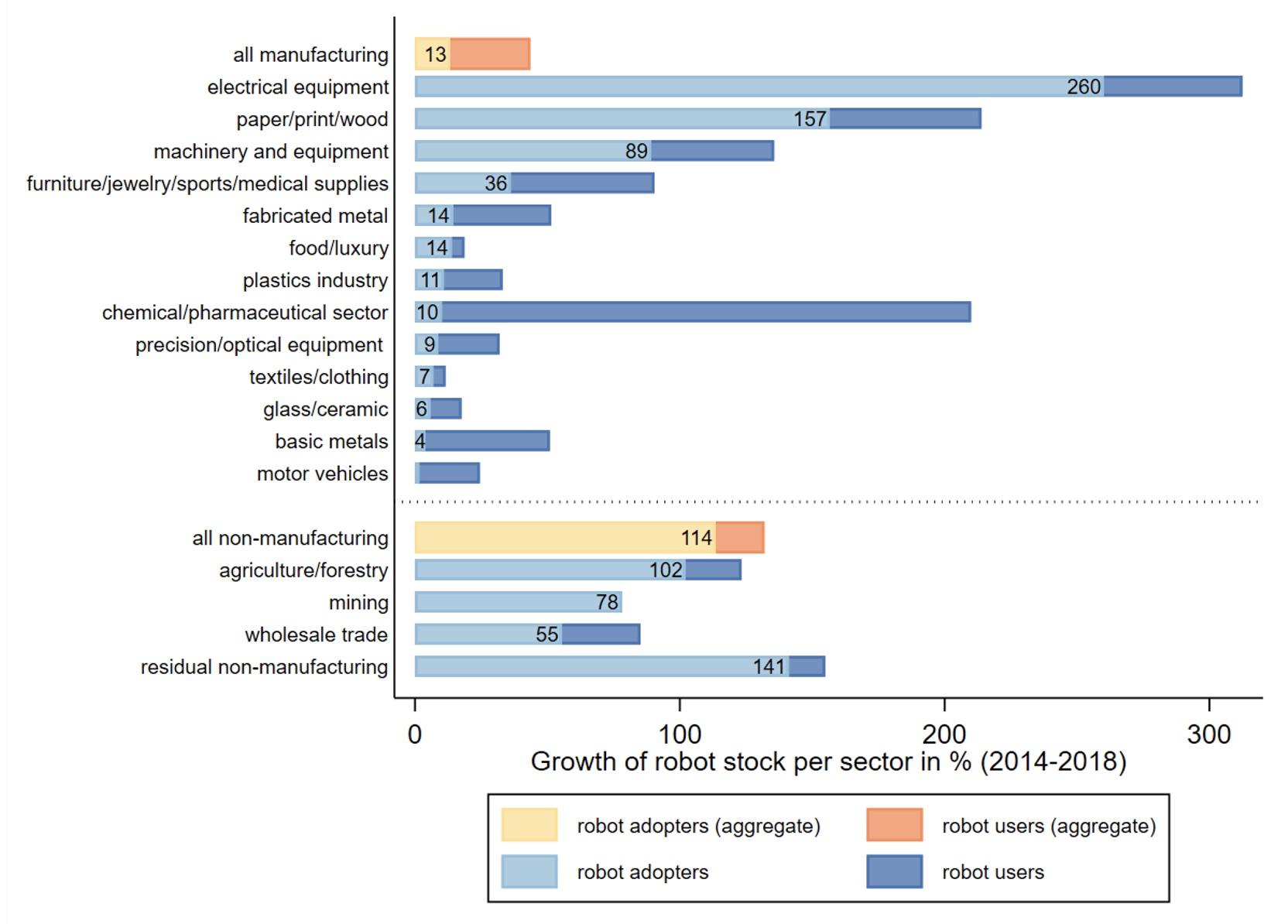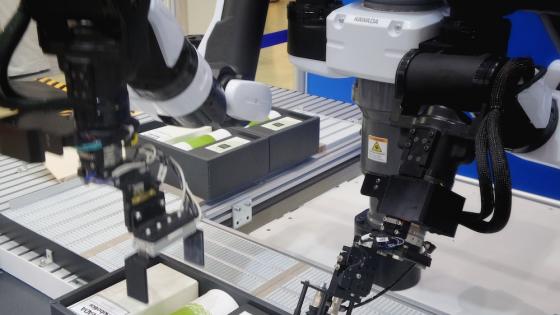The robots are coming. According to a widely cited study, about 47% of total US employment is susceptible to computerized automation (Frey and Rahbari 2016, Frey and Osborne 2017). A heated discussion, stimulated by the current wave of automation, concerns the future of work and society. Recent empirical studies highlight ways that the rising importance of robots in industrial production have transformed the labour market and the economy at large. Following seminal work by Graetz and Michaels (2018), a growing literature has exploited industry-level data from the International Federation of Robotics (IFR) to study the consequences of robotisation for local labour markets (Acemoglu and Restrepo 2020), individual workers (Dauth et al. 2020), and occupational structure (de Vries et al. 2020).
To better understand why production units adopt robots – and the implications of that choice – a nascent body of work delves into microeconomic data. Using Spanish firm-level data, Koch et al. (2019) was the first to document the difference in robot adoption across firms and its labour market implications. Stapleton and Webb (2020) have further shown that robot-using firms in Spain actually led to greater offshoring activities to low-income countries, highlighting the nexus between automation and globalisation. In this regard, Baldwin (2019) points to a broader discussion with the notion of “Globotics” and elaborates how the dual nature of globalisation and robotisation calls for “a thorough understanding of the technical, economic, and political forces shaping globotics”. This burgeoning literature extends its analysis to other European economies, including Denmark (Humlum 2019), France (Acemoglu et al. 2020, Bonfiglioli et al. 2019), and Norway (Barth et al. 2020).
Perhaps surprisingly, much less work has been done on the use of robots in Germany, a country especially known for its robotic innovation, production, and adoption. Largely due to the lack of micro data, the existing work relies either on the IFR industry-level data or on alternative measures of robots (Zator 2019). To fill this void, our recent paper uses a new dataset of robots that we developed to portray the state, recent development, correlates, and potential determinants of plant-level robot use and adoption in Germany (Deng et al. 2020). In what follows, we describe the survey data before presenting five stylised facts, which unveil substantial within-industry heterogeneity, on robot use and adoption for the country with the third highest level of robot intensity in the world (following South Korea and Japan, IFR Report 2018).
Data
Our robot data comes from the IAB Establishment Panel, a high-quality, nationally representative panel dataset that surveys around 16,000 German plants every year. In the most recent 2019 wave, we included a section dedicated to robots. The survey asks (1) whether a plant used robots from 2014 to 2018; if so, (2a) the number of robots used in each year from 2014 to 2018 and (2b) the number of robots newly purchased in 2018; and (3) characteristics of the robots installed. The definition of robots closely follows the ISO definition, and the difference between robots and traditional CNC machines is explicitly stated in the survey.
The resulting dataset is, to our knowledge, the first longitudinal dataset that reports direct robot measures in Germany at the plant level. It is an unbalanced panel of 15,307 plants spanning the years 2014 to 2018. The plant-level data, aggregated to the industry level, is broadly consistent and highly correlated with the industry-level IFR data for Germany.
Fact I: Robot use is rare
The first prominent feature emerging from the dataset is this: Even in a country with very high robot density, robot use is relatively rare at the plant level. In 2018, only 1.6% of plants in Germany were robot users. The manufacturing sector, which has undergone a continued process of robotisation for several decades, saw 8.2% of its plants using robots in 2018. In the non-manufacturing sector, where robotic technology was brought into applications quite recently, 0.9% of plants were robot users in 2018. Despite the small share of robot-using plants, it should nevertheless be noted that in 2018, those plants employed 3.2 million workers, accounting for about 8% of the total work force in Germany.
Fact II: Robot distribution is skewed
Among robot users, robots are highly concentrated within a handful of heavy users, mainly in the manufacturing sector. In 2018, 52% of the total robot stock was owned by the top 5% of robot-using plants in Germany. According to Figure 1, manufacturing plants ranked in the top decile by robot count had 40 robots on average in 2018, 20 times as many as the median number of robots installed in robot-using plants. Within the top decile, the distribution of robots is again highly skewed: The highest two percentiles had, on average, 141 robots. It is worth noting that the distribution of robots is significantly less skewed in the non-manufacturing sector. The median non-manufacturing user installed only one robot in 2018, while the users in the top decile had seven robots on average.
Figure 1 Robot distribution in the manufacturing sector in 2018
Notes: (1) Plants are sorted by the number of robots reported in 2018. (2) The survey weights are applied. (3) Average robot count is rounded to the closest integer. (4) Due to skewed nature of the distribution, the figure is plotted in log scale.
Figure 2 Growth in the extensive margin from 2014 to 2018
Notes: (1) A plant is identified as a robot user in 2018 if it answered ‘yes’ to the question of whether it used robots from 2014 to 2018 and its robot stock in 2018 was not zero. (2) Survey weights in 2018 are applied. (3) The estimated robot share in 2014 is based on a subsample of plants that reported their robot use for the entire sample period.
Figure 3 Decomposition of growth in robot stock: Extensive vs. intensive margin
Notes: (1) Calculations are based on the surveyed plants that reported their robot use in each year from 2014 to 2018. Survey weights in 2018 are applied. (2) For each sector, the contribution of the robot adopters to growth is defined as the ratio of the total robot stock of robot adopters in 2018 to the robot stock aggregated over the existing users in 2014. The contribution of the robot users to growth is defined as the percentage change of the aggregate robot stock from 2014 to 2018 for the plants that already used robots in 2014.
Fact III: More plants start adopting robots
Robot adopters – the plants that adopted their first robots between 2014 and 2018 – made a substantial contribution to growth in both the extensive and intensive margins of robotisation. According to Figure 2, from 2014 to 2018, the share of robot users in the manufacturing sector increased by more than 50%, from 5.16% to 8.22%. The user share in the non-manufacturing sector almost doubled, from 0.51% to 0.94%. Figure 3 disaggregates the growth of robot stock by industry from 2014 to 2018 into extensive and intensive margins. The extensive margin – the contribution of robot adopters to the overall growth of robots from 2014 to 2018 – played an important role in several manufacturing industries as well as the non-manufacturing sector as a whole.
Fact IV: Robot users are exceptional
Robot users differ from non-users in a number of plant-level characteristics. According to the estimates from bivariate regressions, the average plant size of robot users is about 4.2 times as large as that of the non-users. Controlling for plant size, being a robot user is associated with an increase in the share of low-skilled labour in total employment by 2.7 percentage points, in the probability of exporting by 16.9 percentage points, in investment by 88.7%, and in the probability of using up-to-date technology by 9.6 percentage points. Moreover, within the sample of robot users, a 10% increase in robot stock is associated with 3.9% increase in plant size measured by employment.
Fact V: Cage robot users are even more exceptional
With the rise of “cobots” – robots that can be used in collaboration with human workers – the composition of robots in production lines has been changing. According to the survey, only 49% of the German robot users reported using robots that are separated from employees during the regular operations with the help of a protection device (labelled ‘cage robots’), which are distinguished from the newer collaborative robots. It is shown that robotisation premia, as in Fact IV, are more pronounced for cage robot users, which are larger than the other robot users. Conditional on plant size being controlled, cage robot users tend to have higher labour productivity and are much more likely to export.
Potential determinants of robot adoption
Beyond the stylised facts, we investigate the potential determinants of plant-level robot adoption. We are interested in whether the differences between users and non-users, as suggested by Fact IV, existed prior to robot adoption. In light of the task-based theoretical framework in Acemoglu and Restrepo (2018), we focus on five aspects: Plant size, productivity, low-skilled labour share, introduction of minimum wage in 2015, and exporter status. Regression analysis suggests that plant size, low-skilled labour share, and exporter status in 2014 were all positively associated with robot adoption in the subsequent period from 2014 to 2018. The positive effects are statistically significant and economically sizable, echoing the findings in Koch et al. (2019). Manufacturing plants hit by minimum wage regulation are more likely to adopt robots, consistent with recent evidence from China (Fan et al. 2020). The only exception is productivity. Conditional on plant size being controlled, there is no evidence that robot adopters are ex-ante more productive than non-adopters.
Concluding remarks
Thanks to increasing data availability, a rapidly growing literature is investigating robot adoption and its implications at the microeconomic level. Using a new plant-level dataset, we provide a first look at the use and adoption of robots in Germany, the country with the highest robot density in Europe.
Moving forward, we are examining the labour market and productivity effects of robotisation using this new micro-level dataset to complement and extend our earlier work, which relies on industry-level variation in robot adoption (Dauth et al. 2020). With much more disaggregated information, we envisage a better understanding of the nature of robotisation and of the underlying mechanism through which automation impacts plants and workers.
References
Acemoglu, D and P Restrepo (2020), “The race between man and machine: Implications of technology for growth, factor shares, and employment”, The American Economic Review 108(6): 1488–1542 (see the Vox column here).
Acemoglu, D, C Lelarge and P Restrepo (2020), “Competing with robots: Firm-level evidence from France”, AEA Papers and Proceedings 110: 382–388.
Acemoglu, D and P Restrepo (2020), “Robots and jobs: Evidence from US labor markets”, Journal of Political Economy 128(6): 2188–2244.
Baldwin, R (2019), The Globotics Upheaval: Globalization, Robotics, and the Future of Work, Oxford University Press (see the Vox column here).
Barth, E, M Roed, P Schøne and J Umblijs (2020), “How robots change within-firm wage inequality”, Working Paper.
Bonfiglioli, A, R Crino, H Fadinger and G Gancia (2019), “Robot imports and firm-level outcomes: Evidence from French firms”, Working Paper.
Dauth, W, S Findeisen, J Südekum and N Wößner (2020), “The adjustment of labor markets to robots”, Working Paper (see the Vox column here).
de Vries, G J, E Gentile, S Miroudot and K M Wacker (2020), “The rise of robots and the fall of routine jobs”, Labour Economics 66: 101885 (see the Vox column here).
Deng, L, V Plümpe and J Stegmaier (2020), “Robot adoption at German plants”, Working Paper.
Fan, H, Y Hu and L Tang (2020), “Labor costs and the adoption of robots in China”, Journal of Economic Behavior and Organization, forthcoming.
Frey, C B and M A Osborne (2017), “The future of employment: How susceptible are jobs to computerisation?”, Technological Forecasting and Social Change 114: 254–280.
Frey, C B and E Rahbari (2016), "Technology at work: How the digital revolution is reshaping the global workforce", VoxEU.org, 25 March.
Graetz, G and G Michaels (2018), “Robots at work”, Review of Economics and Statistics 100(5): 753–768.
Humlum, A (2019), “Robot adoption and labor market dynamics”, Working Paper.
Koch, M, L Manuylov and M Smolka (2019), “Robots and firms”, Working Paper (see the Vox column here).
Stapleton, K and M Webb (2020), “Automation, trade and multinational activity: Micro evidence from Spain”, Working Paper (see the Vox column here).
Zator, M (2019), “Digitalization and automation: Firm investment and labor outcomes”, Working Paper.
